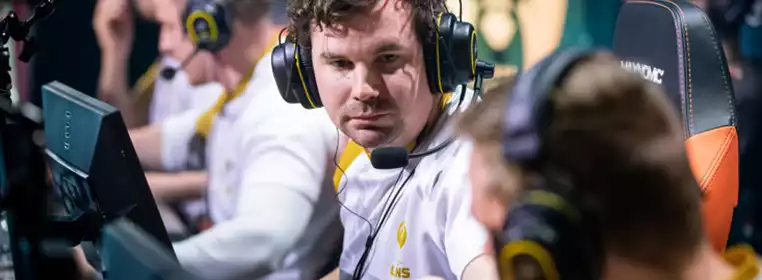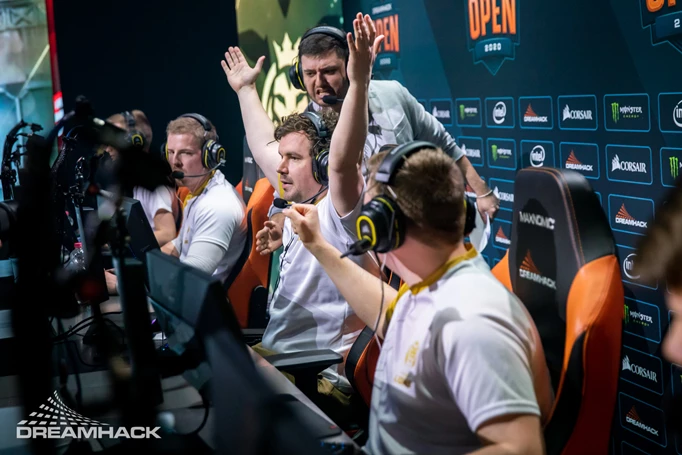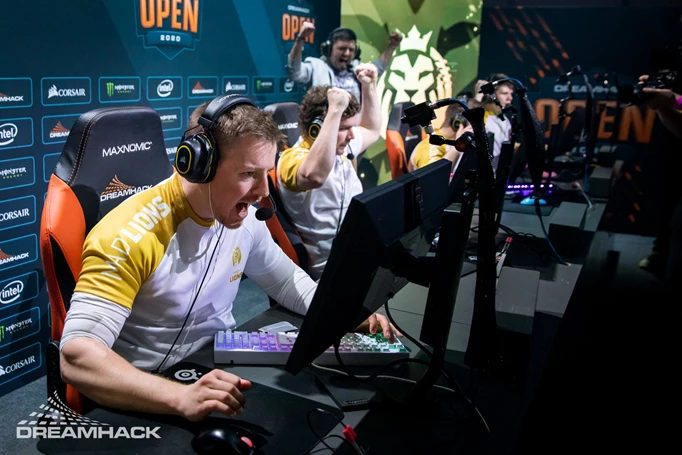stuchiu: Will MAD Lions jump up to the next tier of competition?

The 2020 CS:GO season has started and one of the early surprises of the year is MAD Lions. The Danes reached top four at the first two LAN tournaments of 2020: DreamHack Leipzig and ICE Challenge 2020. With those results, MAD Lions solidified their spot as the second-best Danish team, so the next question is whether they will make the jump up to from a tier 2 team to a tier 1.
MAD Lions' Results
The MAD Lions lineup consists of Nicolai “HUNDEN” Petersen, Frederik “acoR” Gylstrand, Rasmus “Sjuush” Beck, Lucas “Bubzkji” Andersen, and Fredrik “roeJ” Jorgensen. MAD Lions also signed Luis “peacemaker” Tadeu as their coach. While the coach is new, the five-man lineup has played together for about six months when they were still on Tricked Esports.
RoeJ was the last to join on August 22nd, 2019. The squad initially showed promise as Tricked Esports when they won the V4 Future Sports Festival after the StarLadder Berlin Major. The team then had to build themselves up through the online portion of the circuit and at the end of 2019 became regulars at smaller LAN tournaments. They got 2nd at WePlay! Forge of Masters Season 2, 2nd at DreamHack Open Winter, and top four at DreamHack Open Sevilla.
In 2020, MAD Lions have continued to show consistency with a top four at DreamHack Leipzig and another top four at ICE Challenge 2020. While the results are good, in and of itself, it doesn’t explain the hype surrounding the team. GODSENT for instance have similar results across the same timespan. GODSENT won WePlay! Forge of Masters Season 2 over Tricked and got top four at DreamHack Open Winter, DreamHack Open Sevilla, and ICE Challenge.
What impresses people about MAD Lions is the quality of their wins, their age, and map pool. MAD Lions play a structured tactical style, and this has let them put up good fights, most notably their semifinals loss to Mouz at ICE Challenge 2020. As for the age, acoR, Sjuush, and Bubzkji are all around 21 years old. RoeJ is older at 26, but his career is still fairly young as he seems to have started playing competitively in the latter half of 2017. In contrast to that, the GODSENT players are largely known players in the scene. Finally, they have a deep map pool for a tier two team.
MAD Lions’ Map Pool
In their last two LAN events, MAD Lions have played five of the seven maps: Dust2, Mirage, Nuke, Train, and Vertigo. Among those maps, MAD Lions favor Dust2, Mirage, Nuke, and Train as their go to maps. Those are the ones they are willing to play most teams on. Vertigo is more of a joker pick as they’ve only used it to surprise Mouz in the map veto (and succeeded with a 16-13 victory on the map).
As for the final two maps, Inferno is MAD Lions’ permaban and their least played map. Overpass is a floater map. While they don’t like to play it, they are willing to leave it in the map pool as a potential decider if they need to. Among their primary four maps, MAD Lions already have a well-defined structure and identity as a squad.
HUNDENs Structure and Tactics
HUNDEN has been an eternal name within the Danish scene for the last few years. HUNDEN never led a big championship contender, nevertheless he’s been a critical figure in the development of Danish Counter-Strike. His eye for talent, strong ideas of roles, structure, and tactics has given the young Danish players a strong foundation to learn the fundamentals of CS:GO. This philosophy runs through the current MAD Lions lineup. Peter “dupreeh” Rasmussen told GGRecon,
“In that way, that they’re playing really great together as a team. It seems like they have a really strong way in which they have players to determine each role. It’s really good. It’s like it’s set in stone, like everyone is confident about their role. “
On the T-side, HUNDEN and Sjuush take map control. Acor is the AWPer on both sides of the server. Bubzkji and roeJ play the wings as the lurkers, with roeJ likely being their primary lurker while Bubzkji plays more of a secondary lurk or T-side anchor. This structure gives every player a deliberate job, so MAD Lions teamplay is well-practiced. It doesn’t have the insane natural chemistry of a Swedish lineup, but its clean efficient approach makes their executions consistent.

 Click to enlarge
Click to enlargeExecutions and explosive hits are MAD Lions’ biggest calling card as a T-side team. On maps like Mirage, Train, and Nuke, their structured execs and hits is what gives them a fighting chance against any team. When they execute, each player knows where they want to put their smoke, their mollies, their flashes, and what routes they need to run. HUNDEN then mixes this up by having the team run different routes behind the same utility patterns.
On Train, their A exec nades where they smoke off ivy and connector can lead to either an A exec or a fast B hit with roeJ lurking in either ivy or T-main. Dust2 is a similar story as HUNDEN will call for a typical Mid-to-B exec and they can either run the standard or have roeJ lurk around B tunnels, Bubzkji lurk around mid doors, and have the main pack hit the A-site from short. In terms of timing, the team is fairly strict as well as they go around the 1:00 minute to 45second mark. This is perfect for a team filled with younger players as it gives them enough time to execute their strategy without the pressure of the timer, while still giving them some leeway to make a read or play in the round.
As for the CT-side, the primary playmakers are Acor, Bubzkji, and RoeJ. The three of them take the bulk of the action in the early round. As for HUNDEN and Sjuush, they are likely playing the 5 and 4 in HUNDEN’s system, a system that HUNDEN talked about in an interview with Duncan “Thorin” Shields. The 5 and 4 is an idea that HUNDEN co-opted from Dota2. In Dota2, the 4 and 5 players are the support players of the team. They are called the 4 and 5 as they are fourth and fifth in priority when it comes to gold allocation as their sacrifice enables the star players to buy the items they need to win the game. In CS:GO, HUNDEN uses this terminology to explain his own role as leader and his secondary caller. As there are two sites to defend on the CT-side, it’s hard for any single player to call the entire half, so HUNDEN always made sure he had a 4 support that could do secondary calling for the other site. Given that Sjuush plays different sites from HUNDEN, and takes up most of the small-site anchor roles and ramp, it’s likely that he fills the 4 support on this team. Despite that, Sjuush has had surprisingly good impact as both a small-site anchor and entry player.
The ENCE Comparison
To understand whether or not MAD Lions can make the jump to a tier 1 team, we need to understand what it takes for a tier 2 team to make the jump. It is best to use an example so that we have a basic framework of how a team does this.
In that sense, it is best to compare MAD Lions to ENCE of last year before they kicked Aleksi “Aleksib” Virolainen. ENCE were a team on the rise throughout 2018 and by the end of the year were likely the best tier 2 team in the world. In 2019, they broke through and became a top contender for the first half of 2019.
The reason ENCE is the most useful comparison is because of how ENCE did it. Like MAD Lions, it was an all national lineup (albeit Finnish rather than Danish) so they had a single common culture. Like MAD Lions, ENCE as a team got their results primarily through their tactics and teamplay. Their aggressive executes, layering of strategies, and mid-rounding seemed to confound the teams they played against.
However there is one critical difference between the ENCE of early 2019 and MAD Lions today, firepower. During ENCE’s run, both Aleksi “allu” Jalli and Jere “sergej” Salo were top 20 players in the world (I’d argue sergej was comfortably in the top 10 at their height). While the four young Danes of MAD Lions are good, none of them have ascended to that level of play yet. What’s more HUNDEN is a far worse individual player than Aleksib was, so that is another critical factor that could stop MAD Lions progression going into the future.
MAD Lions’ Growth Potential
The biggest X-factor for why people believe MAD Lions could be the next big thing isn’t because of what their players are now, but what their players could become. Bubzkji, roeJ, acoR, and Sjuush are all good players right now, but none of them have found their specialty. All of the best CS:GO players have various specialties where they know they can consistently win out against the large majority of other players in the world. For instance, we know that if Emil “Magisk” Reif is one of the world’s best anchors. Astralis’ control system then enables this even further with their utility control style that runs down the time and resources of the other team. By the time the T-side hit the site, Magisk is in perfect position and will often get 2-3 kills as the enemy team crashes into him.

 Click to enlarge
Click to enlargeWe don’t know how the young MAD Lions players will evolve going forward. However it is crucial that they do as their evolution as players will not only help the firepower of the squad, but help the tactical side as well. In a post game interview, Finn “Karrigan” Andersen talked to HLTV about the flaw in MAD Lions’ current style when played on Dust2,
“I feel that Dust2 doesn't really have much of what they say they're coming with. Normally, when you play Dust2 you need to be able to have really good mid rounds and openings here and there, and executes. What I feel they're best at is executing, and executing all the time on Dust2 is really tough because we're going to try to go for duels and make sure they don't execute their full utility.”
As the players evolve, they will create more openings. As they gain more experience, they will be better at reading the game which will help HUNDEN make better mid-round reads. By increasing their strength in those areas, their tactics should become an even stronger weapon as they will have more tools and ways to win: whether it be through opening duels, better mid-round calls and reads, or increased game sense.
Beyond these potential positives, MAD Lions have two other problems they need to figure out: their map pool and how to play around HUNDEN. While their map pool is fairly flexible, they seem to be focused around their four good main maps of Dust2, Mirage, Nuke, and Train. They need to expand this to include either Vertigo or Overpass as Inferno is their current permaban.
- Read More - Device - Gatekeeper to the Gods
As for HUNDEN, he’s infamous for being a bad individual player. Despite that, he is incredibly important to the success of this team as his knowledge and tactics will be what helps these teams adapt new tactics, develop the strength of the players, and grow their map pool. Given the circumstances and players they have, I suspect they will go down the BIG route.
Back in 2018, BIG had a similar problem as Fatih “gob b” Dayik was their in-game leader. In order to make sure enemy teams couldn’t exploit his weak individual play, Gob b focused on double-AWP setups so that they could get the early pick and hide gob b from potential duels. While not a perfect solution, this is a route that I think MAD Lions will go down.
The Next Team Up?
MAD Lions as they stand now are a good team. They have good tactics, strong structure, and good teamplay. But in order for MAD Lions to get to the next level, the young Danish players will have to take the next step in their careers. They will have to become stars in the global sense. What’s interesting about MAD Lions though is that they don’t need all four to get to the next level. If only two of them can manage it, then that should be enough to help them make the leap to a tier 1 team.
Images via Dreamhack.
